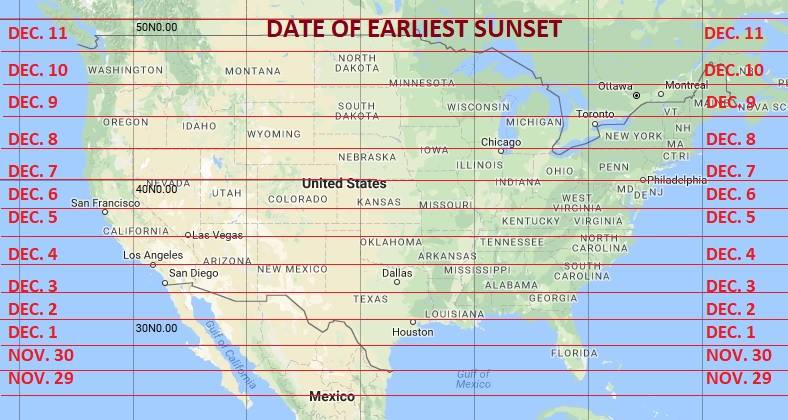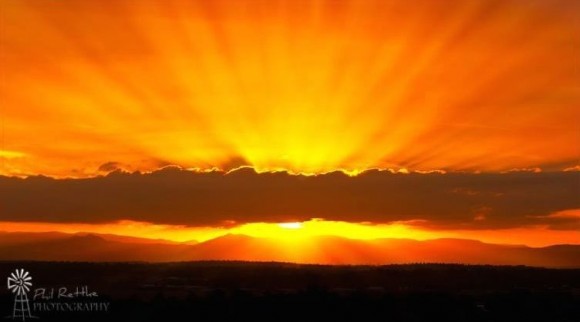

Adrian Strand captured this photo on a beach in northwest England.
The winter solstice is the shortest day. It offers the shortest period of daylight. But, unless you live close to the Arctic Circle or Antarctic Circle, your earliest sunsets aren’t on or even near the solstice itself. Instead, your earliest sunsets will come before the winter solstice. The exact date of earliest sunset depends on your latitude. If you live in the southernmost U.S., or a comparable latitude (say, around 25 or 26 degrees N. latitude), your earliest sunsets are in late November. If you’re farther north – say, around 40 degrees N. latitude – your earliest sunsets are around December 7.

Stephen Aman shares his map of the United States that lists the dates of the year’s earliest sunset for various latitudes. Thank you Stephen!
And if you live in the Southern Hemisphere, your earliest sunrises are coming around now. Southern Hemisphere? Click here.
Why isn’t the earliest sunset on the year’s shortest day? To understand it, try thinking about it in terms of solar noon or midday, the time midway between sunrise and sunset, when the sun reaches its highest point for the day.
A clock ticks off exactly 24 hours from one noon to the next. But the actual days – as measured by the spin of the Earth – are rarely exactly 24 hours long.
So the exact time of solar noon, as measured by Earth’s spin, shifts in a seasonal way. If you measured Earth’s spin from one solar noon to the next, you’d find that – around the time of the December solstice – the time period between consecutive solar noons is actually half a minute longer than 24 hours.
So – two weeks before the solstice, for example – the sun reaches its noontime position at 11:52 a.m. local standard time. Two weeks later – on the winter solstice – the sun reaches its noontime position at 11:59 a.m. That’s 7 minutes later.
The later clock time for solar noon also means a later clock time for sunrise and sunset.
Click here for the December 2018 calendar, giving you the clock time for solar noon (check the solar noon box).
The result: earlier sunsets before the winter solstice and increasingly later sunrises for a few weeks after the winter solstice.
The exact date of earliest sunset varies with latitude. But the sequence is always the same. For the Northern Hemisphere, earliest sunset in early December, winter solstice, latest sunrise in early January.

In early December, the Southern Hemisphere is approaching its summer solstice. Sunset on that part of Earth will continue coming later until early January. Photo of sunset with crepuscular rays by Phil Rettke Photography in Ipswich, Queensland, Australia.
Meanwhile, if you’re in the Southern Hemisphere, take nearly everything we say here and apply it to your winter solstice in June. For the Southern Hemisphere, the earliest sunsets come prior to the winter solstice, which is typically around June 21. The latest sunrises occur after the June winter solstice.
During the month of December, it’s nearly summer in the Southern Hemisphere; the summer solstice comes this month for that hemisphere. So sunsets and sunrises are shifting in a similar way. For both hemispheres, the sequence in summer is: earliest sunrises before the summer solstice, then the summer solstice itself, then latest sunsets after the summer solstice.
As always, things get tricky if you look closely. Assuming you’re at a mid-temperate latitude, the earliest sunset for the Northern Hemisphere – and earliest sunrise for the Southern Hemisphere – come about two weeks before the December solstice, and the latest sunrise/latest sunset happen about two weeks after.
But at the other end of the year, in June and July, the time period is not equivalent. Again assuming a mid-temperate latitude, the earliest sunrise for the Northern Hemisphere – and earliest sunset for the Southern Hemisphere – comes only about one week before the June solstice, and the latest sunset/latest sunrise happens about one week after.
The time difference is due to the fact that the December solstice occurs when Earth is near its perihelion – or closest point to the sun – around which time we’re moving fastest in orbit. Meanwhile, the June solstice occurs when Earth is near aphelion – our farthest point from the sun – around which time we’re moving at our slowest in orbit.

View larger. Computed position of the sun looking eastward at the same time each morning from the Northern Hemisphere. December solstice point at lower right and June solstice point at upper left. Solar days are longer than 24 hours long at the solstices, yet less than 24 hours long at the equinoxes. Roughly midway between a solstice and an equinox, or vice versa, the solar day is exactly 24 hours long.
In short, the earliest sunset/winter solstice/latest sunrise and earliest sunrise/summer solstice/latest sunset phenomena are due to the fact that true solar days are longer than 24 hours long for several weeks before and after the solstices. At and around the solstices, the Earth must rotate farther on its axis for the sun to return to its daily noontime position, primarily because the sun is appreciably north or south of the Earth’s equator.
However, perihelion accentuates the effect around the December solstice, giving a day length of 24 hours 30 seconds. And aphelion lessens the effect around the June solstice, giving a day length of 24 hours 13 seconds.
Bottom line: The earliest sunsets and latest sunrises don’t come on the winter solstice, the shortest day of the year. Instead, earliest sunsets come some weeks before the winter solstice. Latest sunrises come some weeks after it.
Here are more details about the earliest sunsets.
from EarthSky https://ift.tt/2G2Ot1p


Adrian Strand captured this photo on a beach in northwest England.
The winter solstice is the shortest day. It offers the shortest period of daylight. But, unless you live close to the Arctic Circle or Antarctic Circle, your earliest sunsets aren’t on or even near the solstice itself. Instead, your earliest sunsets will come before the winter solstice. The exact date of earliest sunset depends on your latitude. If you live in the southernmost U.S., or a comparable latitude (say, around 25 or 26 degrees N. latitude), your earliest sunsets are in late November. If you’re farther north – say, around 40 degrees N. latitude – your earliest sunsets are around December 7.

Stephen Aman shares his map of the United States that lists the dates of the year’s earliest sunset for various latitudes. Thank you Stephen!
And if you live in the Southern Hemisphere, your earliest sunrises are coming around now. Southern Hemisphere? Click here.
Why isn’t the earliest sunset on the year’s shortest day? To understand it, try thinking about it in terms of solar noon or midday, the time midway between sunrise and sunset, when the sun reaches its highest point for the day.
A clock ticks off exactly 24 hours from one noon to the next. But the actual days – as measured by the spin of the Earth – are rarely exactly 24 hours long.
So the exact time of solar noon, as measured by Earth’s spin, shifts in a seasonal way. If you measured Earth’s spin from one solar noon to the next, you’d find that – around the time of the December solstice – the time period between consecutive solar noons is actually half a minute longer than 24 hours.
So – two weeks before the solstice, for example – the sun reaches its noontime position at 11:52 a.m. local standard time. Two weeks later – on the winter solstice – the sun reaches its noontime position at 11:59 a.m. That’s 7 minutes later.
The later clock time for solar noon also means a later clock time for sunrise and sunset.
Click here for the December 2018 calendar, giving you the clock time for solar noon (check the solar noon box).
The result: earlier sunsets before the winter solstice and increasingly later sunrises for a few weeks after the winter solstice.
The exact date of earliest sunset varies with latitude. But the sequence is always the same. For the Northern Hemisphere, earliest sunset in early December, winter solstice, latest sunrise in early January.

In early December, the Southern Hemisphere is approaching its summer solstice. Sunset on that part of Earth will continue coming later until early January. Photo of sunset with crepuscular rays by Phil Rettke Photography in Ipswich, Queensland, Australia.
Meanwhile, if you’re in the Southern Hemisphere, take nearly everything we say here and apply it to your winter solstice in June. For the Southern Hemisphere, the earliest sunsets come prior to the winter solstice, which is typically around June 21. The latest sunrises occur after the June winter solstice.
During the month of December, it’s nearly summer in the Southern Hemisphere; the summer solstice comes this month for that hemisphere. So sunsets and sunrises are shifting in a similar way. For both hemispheres, the sequence in summer is: earliest sunrises before the summer solstice, then the summer solstice itself, then latest sunsets after the summer solstice.
As always, things get tricky if you look closely. Assuming you’re at a mid-temperate latitude, the earliest sunset for the Northern Hemisphere – and earliest sunrise for the Southern Hemisphere – come about two weeks before the December solstice, and the latest sunrise/latest sunset happen about two weeks after.
But at the other end of the year, in June and July, the time period is not equivalent. Again assuming a mid-temperate latitude, the earliest sunrise for the Northern Hemisphere – and earliest sunset for the Southern Hemisphere – comes only about one week before the June solstice, and the latest sunset/latest sunrise happens about one week after.
The time difference is due to the fact that the December solstice occurs when Earth is near its perihelion – or closest point to the sun – around which time we’re moving fastest in orbit. Meanwhile, the June solstice occurs when Earth is near aphelion – our farthest point from the sun – around which time we’re moving at our slowest in orbit.

View larger. Computed position of the sun looking eastward at the same time each morning from the Northern Hemisphere. December solstice point at lower right and June solstice point at upper left. Solar days are longer than 24 hours long at the solstices, yet less than 24 hours long at the equinoxes. Roughly midway between a solstice and an equinox, or vice versa, the solar day is exactly 24 hours long.
In short, the earliest sunset/winter solstice/latest sunrise and earliest sunrise/summer solstice/latest sunset phenomena are due to the fact that true solar days are longer than 24 hours long for several weeks before and after the solstices. At and around the solstices, the Earth must rotate farther on its axis for the sun to return to its daily noontime position, primarily because the sun is appreciably north or south of the Earth’s equator.
However, perihelion accentuates the effect around the December solstice, giving a day length of 24 hours 30 seconds. And aphelion lessens the effect around the June solstice, giving a day length of 24 hours 13 seconds.
Bottom line: The earliest sunsets and latest sunrises don’t come on the winter solstice, the shortest day of the year. Instead, earliest sunsets come some weeks before the winter solstice. Latest sunrises come some weeks after it.
Here are more details about the earliest sunsets.
from EarthSky https://ift.tt/2G2Ot1p

Aucun commentaire:
Enregistrer un commentaire